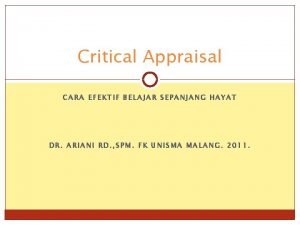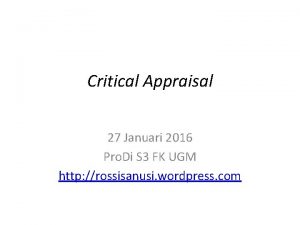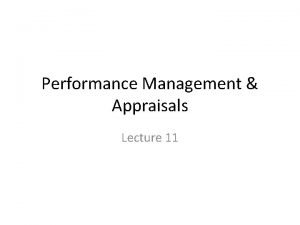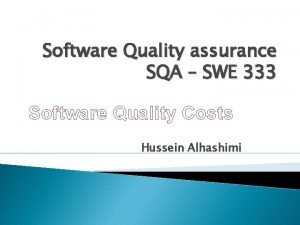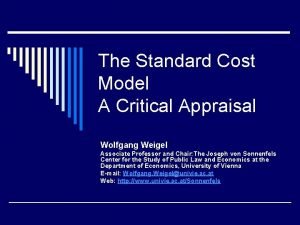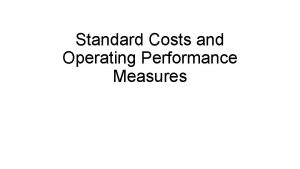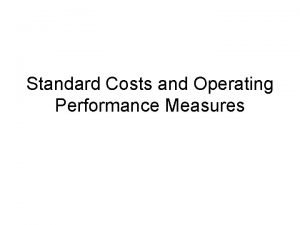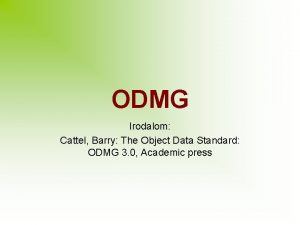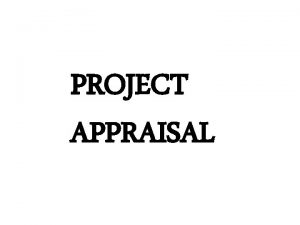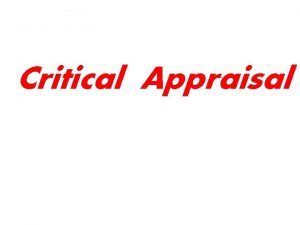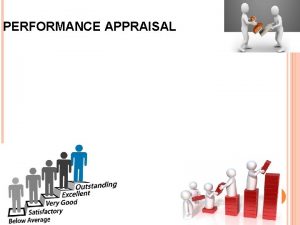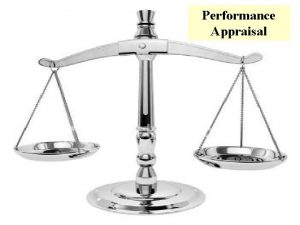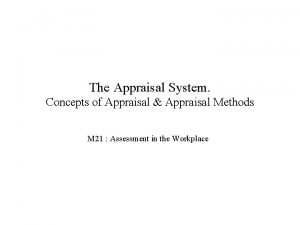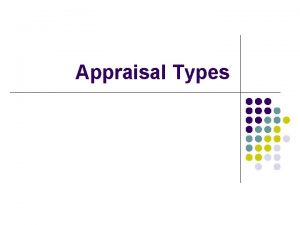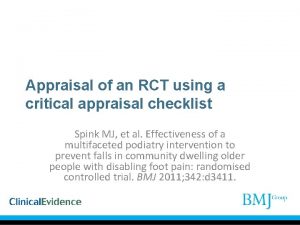The Standard Cost Model A Critical Appraisal Wolfgang

















- Slides: 17

The Standard Cost Model A Critical Appraisal Wolfgang Weigel Associate Professor and Chair: The Joseph von Sonnenfels Center for the Study of Public Law and Economics at the Department of Economics, University of Vienna E-mail: Wolfgang. Weigel@univie. ac. at Web: http: //www. univie. ac. at/Sonnenfels

The Standard Cost Model… Contents o Scope of the paper and background: „Less and better regulation“ o The Standard Cost Model (SCM): What it is about o SCM summarized o SCM Results illustrated o Problems with SCM o A summary view on findings o Conclusions

Scope and background: o „Less and better regulation“ is a catch phrase in both the o o OECD (Organization for Economic Cooperation and Development) and the EU Its goals are most prominently reflected in the attemps to install RIA Many look at regulation as giving rise to excessive bureaucracy and exploitation through state power… However, one must not forgest that regulation at the same time serves a certain purpose in the presence of market failures Tools such as SCM, which are widely cheered upon appearance, mainly are focussing on the cost of regulation only. They are presumed to be a quick and effective tool for cutting „red tape“

The Standard Cost Model – what is it about? o SCM aims at identifying, measuring and assessing the cost accruing to businesses when complying with administrative demands – „administrative burdens“ o Once the cost are known reductions can be sought (the rationale being the potential increase in output, employment, and growth → see The World Bank: „Doing business in 2005 removing obstacles to growth“, and other sources) o A good thing! So: Why bother? o To see this, the SCM first needs to be explained

The Standard Cost Model summarized Chart 1 The Costs of Regulation to Businesses Direct financial cost (e. g. taxes) Compliance costs Substantive compliance costs (e. g. installing filters) Long-term structural costs Administrative costs (e. g. obligatory reports to the government)

Chart 2 Overall administrative costs Business administration costs Administrative costs from central government or EU regulation Admin. Activities which would continue even if regulation were removed (e. g. trust enhancing information for consumers) Administrative burdens (activities which are conducted by businesses because there are obligations to information)

Chart 3 Legal norm (listed as accruing at each ministry) Identification of obligation to provide information in each law Finding the data (experts and council) Identify the administrative activities Time X wage-rate + one-time outlay Cost per andmin activity: P No of firms X frequency of info Number of activities: Q Cost of administrative burdens = P X Q

The Standard Cost Model – Results illustrated o Austria: Survey of 2007: Legal norms: 561, information obligations: 5687, total burden: € 4, 3 Billion (1, 66% of nominal GDP) o Compared to UK: 1, 5% of GDP, Denmark: 1, 9% of GDP, Netherlands: 3, 7% of GDP, USA: 1% of GNP (estimate) – Source: World Bank o Goal: Cut by 25% until 2010 for national law, 2012 for EU regulations o Differences depend on in- or exclusion of „business as usual costs“ (see chart 2)

The Standard Cost Model – Problems 1 o There is an aggregate measure (€ 4, 3 Billion) o There is an aggregate goal ( -25 %) o There is a derived goal such as a boost of GDP by 1, 5% and of labour productivity of 1, 7% (Source: OECD) o But the goal can only be accomplished by considering each act individually – that is by utmost disagregation o And (not only) the accomplishment of the derived goal rests on strong and delicate assumptions

The Standard Cost Model – Problems 2 o Nowhere in the literature it is mentioned that obligations to inform are a consequence of market failure – as is regulation in general (a perfect world does not need regulation) o Only implicitly at least in the manuals and the literature it is presumed that obligations to inform can be badly designed, thus causing excessive burdens o Only more recently there is awareness of the need to have a look on costs (saved) and benefits (forgone) for each of the obligations to information (See European Commission „Impact Assessment Guidelines“ 2005 o Without that, there is little use of SCM for a more comprehensive RIA

The Standard Cost Model – Problems 3 o The problem with the understanding of obligations to inform is that it is assumed that businesses comply to the request. Strategic action is assumed away. o One consequence is that SCM fails to comprise likely „secondary cost of information“, which typically accrue to consumers, when they doubt the information provided by firms, so that they have to undergo efforts to find out (think of fractions of genetically manipulated crop in foodstuff) o Succesful application if the SCM causes spillovers or externalities e. g. by making advice from experts superfluous. Thus value added will be alleviated

The Standard Cost Model – Problems 4 o When it comes to the calculation of the cost af an administrative activity, only „normally efficient firms“ are considered o To illustrate: When one firm reports 5 Minutes for an activity, the host of firms between 15 and 20 minutes, and one firm 50 minutes then the first and last firm are excluded as outlayers – without a check for the reasons o However, it could well be that in one firm a non-skilled worker and in the other an academic does the job o To learn about the problems associated with administrative burdens benchmarks should be adopted instead of simplifying „nomally efficient firms“

The Standard Cost Model – Problems 5 o Another tricky issue is that of the reference date and the subseqent application of measures to cut administraitve burdens o One has to clarify what to do with new laws (include or exclude), amended laws etc. o And, even harder to accomplish, how to control for entries and exits (bankruptcy) of firms

The Standard Cost Model – Problems 6 o A word must be said about the expected gains o Analysts favouring SCM seem not to be aware of x- inefficiencies o Lowering the administrative burden does not automatically leave resources for additional output, when the firm is not producing at the production possibility frontier o Lowering the administrative burden can even lead to the dismissal of employees, thus not increasing but even decreasing the economy‘s value added o And finally: Some information by firms may be e. g. trustenhancing. Thus it is meant to push sales. And in that case it is not an administrative cost in the narrow sense, but a production cost…

The Standard Cost Model – Findings Administrative burdens exist for at least two different reasons § It is „market failure“, which give rise to strategic action, which in turn call for regulation inclusive of obligations to inform § True regulatory activities can cause excessive bureaucracy and other types of „government failure“ § § So there are costs and benefits Where the situation is further complicated by the fact that regulation ranges from outright prohibition to deterrents and incentives

The Standard Cost Model – Findings o The assumptions of the SCM violate standard assumptions of economics (according to the Austrian Manual of SCM „eterprises are compliant and public administration acts according to the rules“ (!) o The possibiltiy to exactly measure administraitve burdens has eventually be doubted by experts (The Austrian Statistical Office publishes a barometer of stress and strain, in which they shy away from monetary measures and confine them to time consumed, because „ …the neglect of differences in the qualification of processors will make the valuation in money terms very problematical“) o Upon investigation in books on accounting for administrative costs in firms is rather unusual – thus of little help

The Standard Cost Model – Conclusion o While economies evidently suffer from red tape o o immediate measures (or even cures) are rare SCM is an ambitious and perfecty understandable attempt to fill a gap However, as hopefully has been shown in the paper, it can be dangerous to follow the temptation of simplicity It might have been worthwhile to spend the efforts in the further development if RIA It could well be that a more advanced SCM can be helpful, but this should be explored by a pilot study, which allows for the consideration of some of the points made in this critical assessment
 Critical semi critical and non critical instruments
Critical semi critical and non critical instruments Critical semi critical and non critical instruments
Critical semi critical and non critical instruments Manufacturing variance analysis
Manufacturing variance analysis Standard cost accounting
Standard cost accounting Critical appraisal adalah
Critical appraisal adalah Critical appraisal of mission statements/corporate aims
Critical appraisal of mission statements/corporate aims Ramboman analysis
Ramboman analysis Contoh critical appraisal jurnal systematic review
Contoh critical appraisal jurnal systematic review Axis tool for cross sectional studies
Axis tool for cross sectional studies A critical incident employee appraisal method collects
A critical incident employee appraisal method collects Which of the following is not an appraisal cost in sqa?
Which of the following is not an appraisal cost in sqa? Altran nord
Altran nord Standard cost model
Standard cost model Standard cost model
Standard cost model Standard cost operating statement
Standard cost operating statement Standard cost model
Standard cost model Slidetodoc.com
Slidetodoc.com Lazarus model of appraisal
Lazarus model of appraisal




